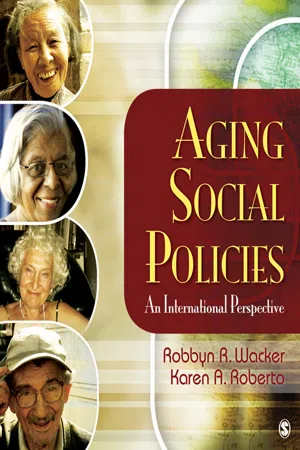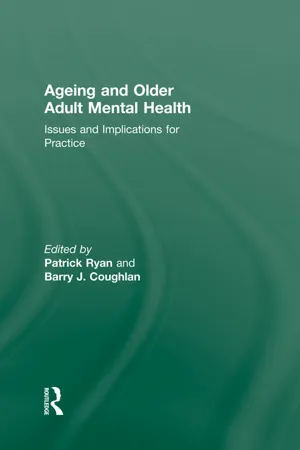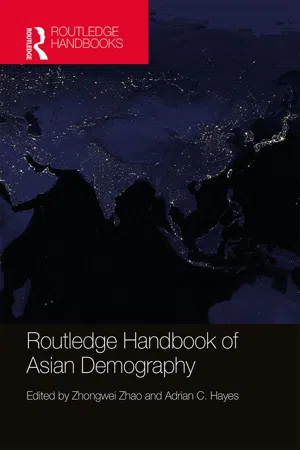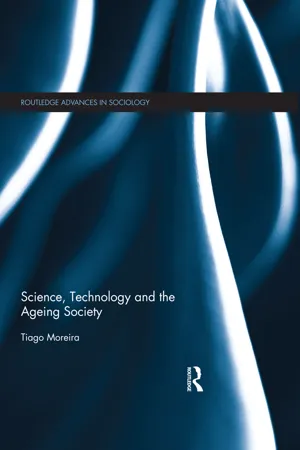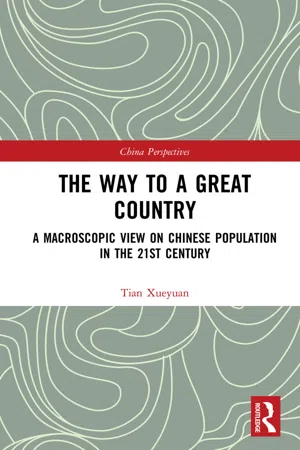Social Sciences
The Ageing Population
The ageing population refers to a demographic trend characterized by a growing proportion of elderly individuals within a society. This phenomenon is often attributed to declining birth rates and increased life expectancy. It has significant implications for healthcare, social welfare systems, labor markets, and family structures, leading to challenges and opportunities for policymakers and society as a whole.
Written by Perlego with AI-assistance
Related key terms
9 Key excerpts on "The Ageing Population"
- As will be argued, there are in fact many different paths likely to be followed by ageing populations. These will reflect factors such as social and cultural variations across different societies, contrasting levels of resources within and between countries, differences in the speed of demographic change and contrasting attitudes towards older people and the idea of ageing. The purpose of this chapter is to review the key demographic drivers behind population ageing, setting these within the broader global context which forms the organizational framework for this book. The chapter first reviews the development of population ageing, defining in the process what is meant by the term ‘ageing societies’. It goes on to survey contrasts between different societies – both within high-income countries and in comparison with low-income countries of the global south. We will also consider gender and social class variations in life expectancy, and the rise of the very elderly population (including the increasing number of centenarians). The discussion then places population change within a sociological context, examining questions about the link between the development of ageing and individual beliefs and attitudes. Finally, the chapter considers a theme which will be returned to at various stages throughout the book: Why are ageing populations often presented as a ‘problem’? What is the historical context for this? What alternative arguments might be developed in response to such views?Population ageing in the twenty-first centuryThe ageing of populations was one of the most important developments of the twentieth century and will raise major challenges for life in the twenty-first. The proportion of the global population aged 65 and over in 1900 was 1 per cent (UK 5 per cent); in 2000 it was 7 per cent (UK 16 per cent) and by 2050 it is estimated that it will be 20 per cent, a figure that the UK is likely to reach in 2020. Population ageing refers to both the increase in the average (median) age of the population and the increase in the number and proportion of older people in the population. This change arises during the move from a demographic regime of high fertility and high mortality to one of low fertility and relatively low mortality. The former is associated with fast-growing young populations; the latter with more stable populations including a larger proportion of people in the older age groups. This process is described in the demographic transition model , derived from observations of the experiences of West European countries over the course of the nineteenth and twentieth centuries. Two clear phases are identified in this model. In the first, mortality rates decrease as a result of economic growth, improved material well-being and advances in public health. Fertility rates stay high, however, leading to a rapid increase in the size of the population, reinforced by higher survival rates through childhood and beyond. Moving into the twentieth century, a second phase unfolds, with a decrease in the number of babies being born and greater prominence and awareness of older age groups (reflected, for example, in concerns about the danger arising from ‘declining populations’ expressed in the 1930s and 1940s).1
- eBook - ePub
Aging Social Policies
An International Perspective
- Robbyn R. Wacker, Karen A. Roberto(Authors)
- 2010(Publication Date)
- SAGE Publications, Inc(Publisher)
carer , the latter word being most often used in European countries to identify a person in the family designated to provide care and support to an elderly family member. Because we feel that it is important to honor these and other linguistic distinctions throughout the book, you will see differing spelling and usage of these terms.For the remainder of this chapter, we will discuss in more detail one reason why aging social policy has risen to the forefront of political discourse across the globe—the growing number of older adults. We will discuss what has contributed to this increase and provide an overview of population aging statistics worldwide.Population Aging
When we use the term population aging, we are referring to the demographic characteristics of a country whereby its older adults—usually those over the age of 60 or 65—account for an increasing proportion of the total population. In this next section, we will discuss factors that are responsible for an increase in the aged population and the extent of population aging in the United States and other countries. We have provided definitions of the demographic terms we use in this chapter in Box 1.1 .BOX 1.1 Demographic DefinitionsTotal fertility rate: the average number of children a woman would bear over the course of her lifetime if current age-specific fertility rates remained constant throughout her childbearing years (normally between the ages of 15 and 49)Life expectancy: the average number of additional years a person of that age could expect to live if current mortality levels observed for ages above that age were to continue for the rest of that person’s life. So life expectancy at birth is the average number of years a newborn would live if current age-specific mortality rates were to continue, and life expectancy at age 65 - eBook - ePub
Global Ageing in the Twenty-First Century
Challenges, Opportunities and Implications
- Zachary Zimmer, Susan A. McDaniel(Authors)
- 2016(Publication Date)
- Routledge(Publisher)
Chapter 1Global Ageing in the Twenty-First Century: An Introduction
Zachary Zimmer and Susan McDanielThe title of this volume implies a reality of which large numbers of demographers, economists, sociologists, geographers, policy-makers, and casual observers of global demographics are well aware. The world at this moment is experiencing an unprecedented change in its global age structure; a phenomenon commonly referred to as population ageing. Specifically, population ageing is a dynamic process wherein a growing proportion of people occupy the older range within an age structure. The definition of the specific age at which a person turns old is unimportant since population ageing is occurring regardless of the criteria that define old age, including criteria that may be cultural, political or practical.It is not hyperbole to say that the ageing of the global population will be among the most important phenomena driving policy around the world over the next number of decades. What observers and interested parties do not always realize is that population ageing is taking place not only on a global level, and not only within certain countries, but it is occurring in nearly every country in the world, and certainly within every region of the planet. Population ageing is a phenomenon that is therefore shared across countries and regions that exist thousands of miles apart. It is shared across countries that may have little else in common. It is happening in rich parts of the world and poor parts of the world. It is occurring in countries that are less developed, with newly emerging economies and in countries with long standing advanced economies. It is occurring in countries that have a very small proportion of their population in old-age and in those that already have a large share of older people.Interestingly, demographically speaking, the causes of population ageing are also generally similar regardless of the country. As will be outlined in more detail below, population ageing is primarily a function of reductions in fertility, or a decrease in the number of children that are born. It is secondarily a function of changes in mortality, with a reduction in the rate at which older adults die. But, while the causes are similar, the consequences and challenges that are faced by various countries differ enormously. One of the key factors that contribute to the consequences of population ageing is the speed at which it is taking place. It is extremely rapid in some countries and more modest in others. - eBook - ePub
Ageing and Older Adult Mental Health
Issues and Implications for Practice
- Patrick Ryan, Barry J. Coughlan(Authors)
- 2013(Publication Date)
- Routledge(Publisher)
Ageing may be viewed as the accumulation of changes in an organism or object over time. Biologically, ageing is defined as a deteriorative process, a fact that has almost become the very definition of ageing in current thinking. In humans though, ageing refers to a multidimensional process of physical, psychological and social change. Some dimensions of ageing grow and expand over time; whereas others decline, e.g. reaction time may slow with age whereas knowledge and wisdom may increase. Research shows that late in life potential exists for physical, mental and social growth and development. This could be termed as ‘successful ageing’ as it refers to optimal physical, psychological and social possibilities for living. It points to an experience of ageing where health, activity and role fulfilment are better than supposedly found within the population generally (Rowe & Kahn, 1997). Ageing therefore is part of what makes up society and it captures not just biological changes that occur across the lifespan for people but also reflects the prevailing cultural and societal conventions related to growth and development that a particular person experiences at a given time.Demographic changes in societyWe are led to believe that we live in an ageing society and actuarially this seems to be the case. In the developed and developing world, people are living longer, and increasing longevity across societies is both a major societal achievement, and a challenge (World Health Organization [WHO], 2002). A combination of low fertility rates and increased life expectancy has resulted in the relative ageing of societies worldwide. The United Nations Department of Economic and Social Affairs (2004) reported that 5.2 per cent of the world’s population was over the age of 65 in 1950, and that this had risen to 6.9 per cent by 2000. Furthermore, it predicted that this percentage would reach 15.9 per cent by 2050 and 24.4 per cent by 2100. Overall, a 238.4 per cent increase in the number of older adults globally is projected between 2000 and 2050. In more developed regions, people over the age of 65 make up 14.3 per cent of the population in 2000 and this will increase to 25.9 per cent by 2050. In Ireland, the Central Statistics Office (2004) predicted that the population would grow from approximately 430,000 in 2001 to between 1.119 and 1.146 million in 2036 – thus more than doubling in size over a space of 35 years. In the UK, the Office for National Statistics (2009) found that the percentage of the population aged 65 and over increased from 15 per cent in 1983 to 16 per cent in 2008, an increase of 1.5 million people in this age group. It also predicted that by 2033, 23 per cent of the population will be in this age group. In the European Union (EU), Giannakouris (2008) found that the percentage of the population aged 65 and over is projected to increase from 17.1 per cent (84.6 million) to 30 per cent (151.5 million) by 2060. Statistics also show that in developing countries the demographic transition occurred much faster than developed countries. In France, it took 120 years for the proportion of elderly people to increase from 7 to 14 per cent. Developing countries like China, Malaysia, Jamaica, Brazil and Thailand will have had a doubling of their older adults from 7 to 14 per cent in less than 30 years (Global Health through Education Training and Service, 2005). - eBook - ePub
The Social Context of Ageing
A Textbook of Gerontology
- Christina Victor(Author)
- 2004(Publication Date)
- Routledge(Publisher)
In the United Kingdom in particular this framework has had a profound influence upon the study of ageing and in generating knowledge about the social context of ageing. The emphasis upon the 'problems' of ageing means that our knowledge and understanding of other non-problematic dimensions of ageing remains sparse. This type of framework can also be seen in the priority areas identified for research by bodies such as the Economic and Social Research Council (ESRC) and the Medical Research Council (MRC) who are concerned with the potential 'future burden' of health and illness among older people and advances a research agenda that is concerned with such matters. The ESRC Growing Older programme also demonstrated a concern with many of the perceived 'problematic' dimensions of growing older and has a heavily social policy focus. There remains little interest from funding bodies or research organisations in the 'everyday life' of older people nor in the study of problems identified by older people rather than policy makers (Gubrium and Holstein, 2000; Bytheway, 2003).Developing theory in social gerontology
There are a number of different explicit theoretical frameworks concerned with the study of ageing. Psychological and physiological perspectives upon ageing focus upon the changes which happen to individuals. However, when focusing upon the social context within which ageing occurs, both for groups and individuals, then theories derived from sociological perspectives are most pertinent. As noted earlier, a concern with examining and understanding the social context of ageing involves studies which look at questions concerned with the adaptation of individuals (a microscale approach) and of questions posed at the macroscale (i.e. concerns with the impact of ageing upon social structures and vice versa). Social theories of ageing are characterised both by the level of explanation at which they operate and by the assumptions and ideologies that underpin them. Aroni and Minichiello (1992) developed a typology of theories including both the level of analysis (micro versus macro theories) and nature (interpretist contrasted with normative theories such as role theory). When evaluating the theories summarised below, and when encountering others not covered here, the student of gerontology needs to consider four basic questions: What is the level of explanation at which theory x - eBook - ePub
- Danny Dorling, Stuart Gietel-Basten(Authors)
- 2017(Publication Date)
- Polity(Publisher)
In the post-industrial countries, ageing has been presented as an existential threat to the very viability of a future welfare state and health-care system. The burden of ageing on every aspect of public expenditure is picked over and analysed in academic, popular and policy documents and discussed on a daily basis in some news story somewhere in the world. The capacity of states to provide adequate pension coverage or universal health care, in the context of ever more complex and expensive medical treatments, clearly looks threatening given what appears to be an exponential increase in the number of older people. In many poorer countries, meanwhile, the threat from population ageing is generally related more to the apparent lack of capacity to provide cheap labour to fuel economic growth, rather than to sickness, and often poverty, in old age.To put it simply, the prevailing view of population ageing is based on an outmoded, increasingly inappropriate view of what it means to be ‘old’. In this vein, we discuss some alternative ways of conceptualizing what being ‘old’ might mean in the twenty-first century – taking into account the huge changes in life expectancy that have occurred in recent decades. Apart from in the UK and US, with their current health and political crises (Hiam et al., 2017a), these increases as yet show little sign of abating in the majority of countries worldwide. Building on this, we then explore some other ways of assessing the changes over recent decades, and those projected into the future, which are likely to fundamentally alter how we envisage ‘old age’. We also consider how preventive medicine and preventative social policy can shape an alternative future – developing the notion, presented in Chapter 3 - eBook - ePub
- Zhongwei Zhao, Adrian C. Hayes(Authors)
- 2017(Publication Date)
- Routledge(Publisher)
In the longer term, demographic transition theory indicates that population ageing will end and age structures will be much older than they are today. With such prospects, it is highly likely that states will take steps aimed at increasing fertility. Such steps have been implemented in Japan, while China recently abandoned its one-child policy. 17 However, policies aimed at increasing fertility have proved unsuccessful in Japan (Tsuya 2015) and around the world (McDonald 2013). Further, such policies naively assume that the issues of population ageing can be addressed through long-term mitigation. In contrast, and by necessity, families are meeting the challenges of ageing through the adaptation of traditional norms to present-day realities. Rather than focus on the uncertain long term, state policies that support such adaptation, through state social security systems and other enabling measures, would seem more appropriate and may offer synergies. In the short to medium term, how societies meet the social security challenges of population ageing will determine the well-being of the older and working generations alike. The earlier these challenges are addressed, the easier it will be to do so, and the more effective the outcome. Acknowledgements The author is grateful to Xiaoguang Jia for research assistance including the creation of figures and tables and to Cuc Hoang for contributing knowledge from her doctoral research on Vietnam. This chapter has benefited from helpful comments from Rafal Chomik and the editors, Zhongwei Zhao and Adrian Hayes. Notes 1 The stable population model describes a theoretical population in which fertility and mortality rates remain constant and the population is closed to migration. In the long term, the age structure of the population and the population growth rate will become constant. The model can be used to demonstrate the long-term implications of current fertility and mortality rates if they were to persist - eBook - ePub
- Tiago Moreira(Author)
- 2016(Publication Date)
- Routledge(Publisher)
The ‘ageing society’ and its othersIntroduction
In the previous chapter, I proposed that the ‘ageing society’ should be thought of as an epistemic assemblage. In this, I foregrounded the knowledge making procedures and institutions, the techniques and technologies that shaped how we come to see our societies through a demographic, population prism. I argued that there were two constituents in this assemblage: one related to how the actuarial sciences came to mediate the relationship between the mechanism of life and the economy in ‘insurance societies’, the second related to how demographic and actuarial forecasts were called into question and prompted a collective search for a new epistemic architecture that was not only concerned with fertility and mortality but also with issues of health production and the ‘environmental’ manipulation of functionality.But why was further knowledge on health and productivity seen as the solution to the ‘ageing society’? This might seem like an odd question given the societal normative consensus on the value of health and wellbeing for individuals and populations. Drawing on Foucault’s writing on biopolitics, explored in the last chapter, scholars have proposed that advanced liberal democracies have experienced shifts in the way the ‘mechanisms of life’ are known and managed. Rose (2009), for example, has suggested that, in contemporary societies, biopolitics has increasingly focused on the deployment of ‘human vitality and morbidity’ in detriment of problematisations of mortality, in what he called a ‘politics of life itself’ (also Rabinow and Rose, 2006; Wahlberg and Rose, 2015). Palladino and I (2008) have argued however that instead of positing a substitution of life for death, we should conceive of those terms entering a new relationship. - eBook - ePub
The Way to a Great Country
A Macroscopic View on Chinese Population in the 21st Century
- Tian Xueyuan(Author)
- 2019(Publication Date)
- Routledge(Publisher)
3 The acceleration trend in population agingExploring the path of reforms for unified old-age security
The aging trend in population in the 21st century
Post-demographic transition, characterized by low births, low deaths, and low growth, leads populations to progressively age, which, like a boat on rising water, cannot be stopped, giving population development in the 21st century a prominent mark. Developed countries were the first to start the post-demographic transition and for a long time, they have led the global trend of population aging; now that developing countries, one group after another, are and will be pushing into the wave of population aging with scales and speeds that developed countries have never seen, how are we going to withstand the unprecedented grey tide?The aging trend in the world population
The 20th century saw explosive growth in population: the world population grew 2.83 times from 1.60 billion in 1900 to 6.12 billion in 2000, with an average annual growth rate of 1.35%, marking historically high population growth.1 However, great disparities exist between developing and developed countries due to unbalanced development of economies, science and technology, cultures, and societies. Developing countries still have growing populations while developed countries have weakened growth, with some even reaching zero or negative growth, setting their feet in the age of “grey tides.”Western and Northern European nations such as France and Sweden were the first to transition to an aged population structure, and, by 1950, those at or above 60 years of age accounted for 11.7% in developed countries, and those at or above 65 accounted for 7.9%, marking developed countries as a whole with an elderly age structure. Developing countries, in contrast, have only 6.4% and 3.9% of these two age groups, typical of a young age structure.
Learn about this page
Index pages curate the most relevant extracts from our library of academic textbooks. They’ve been created using an in-house natural language model (NLM), each adding context and meaning to key research topics.

